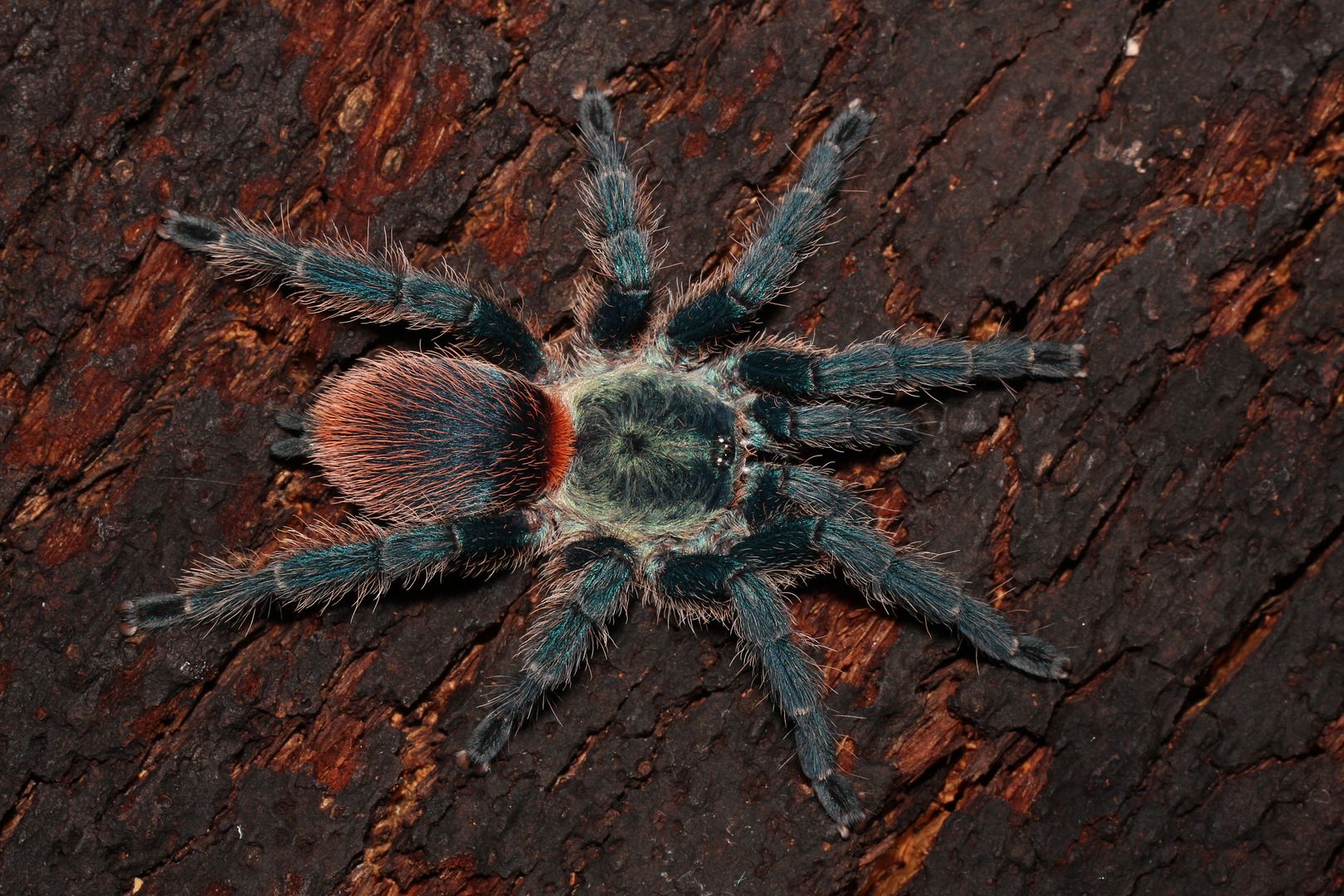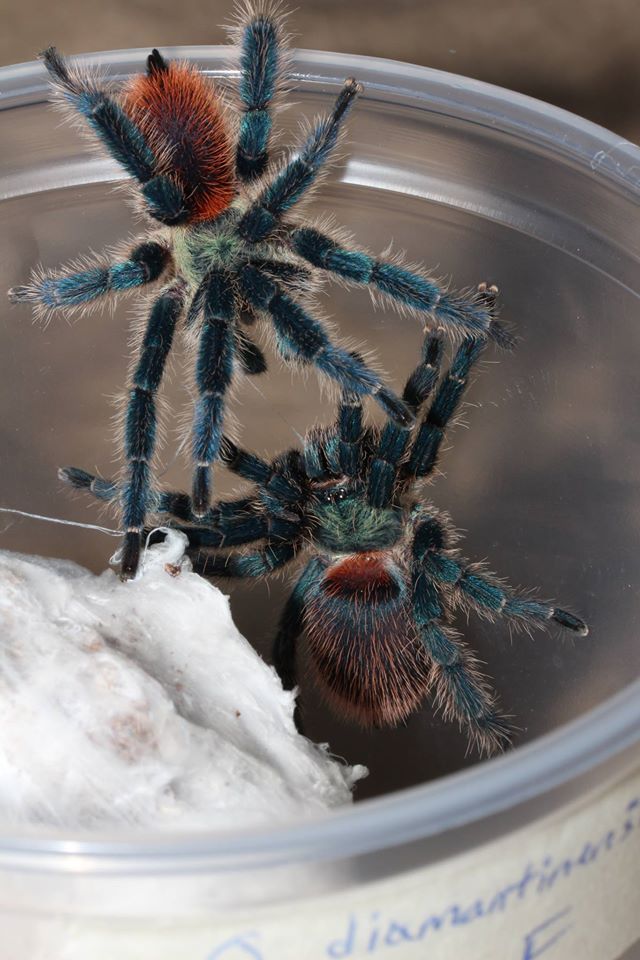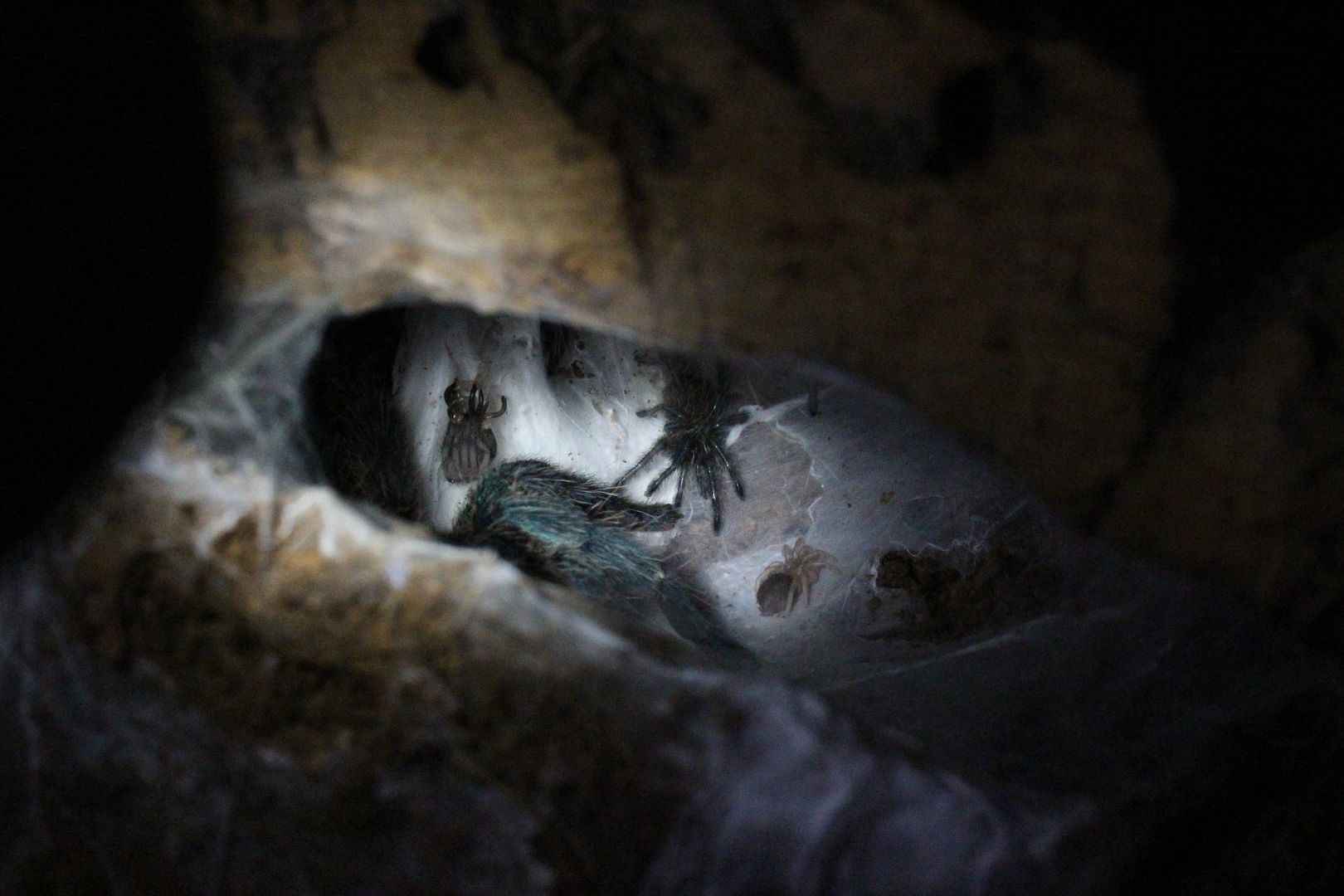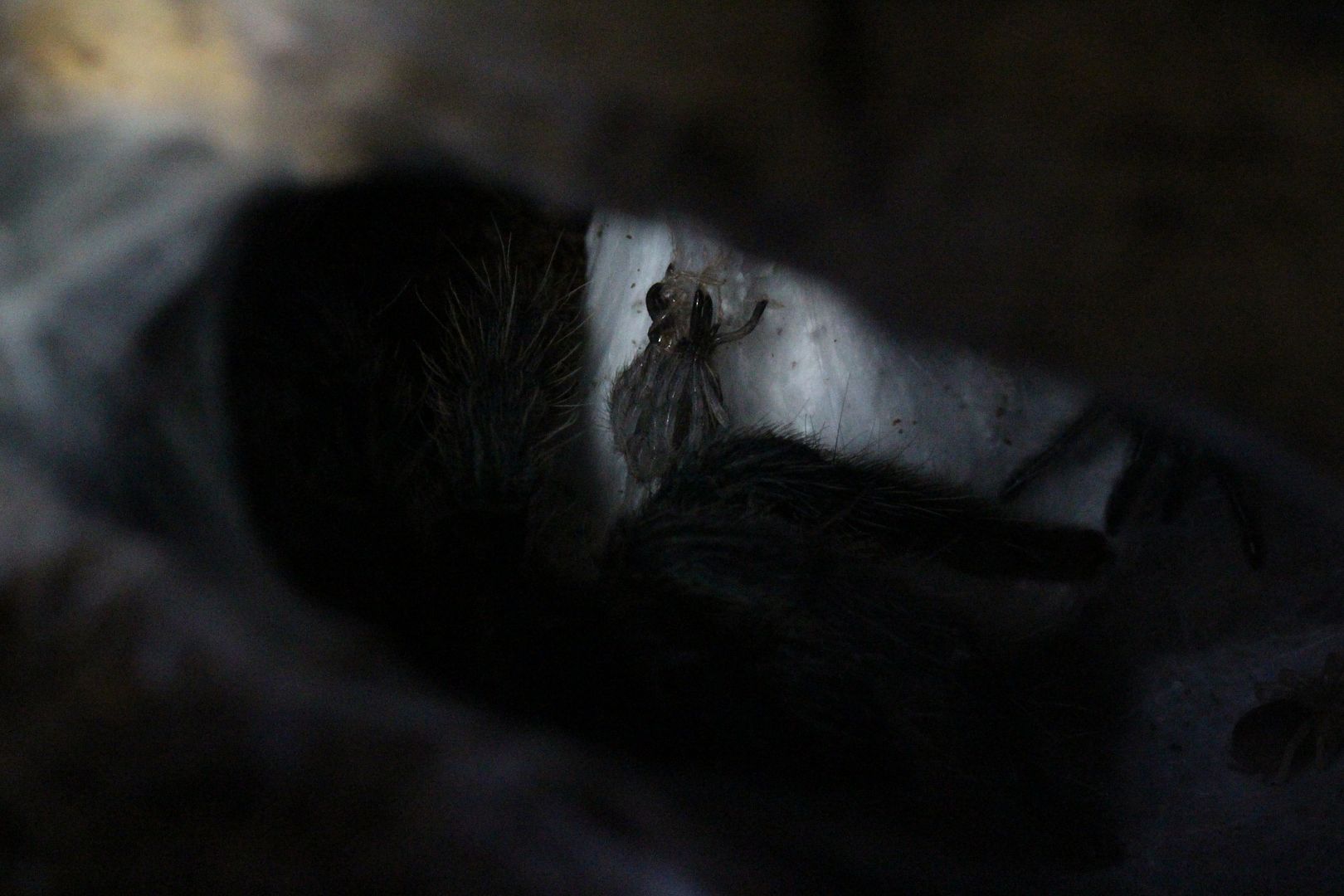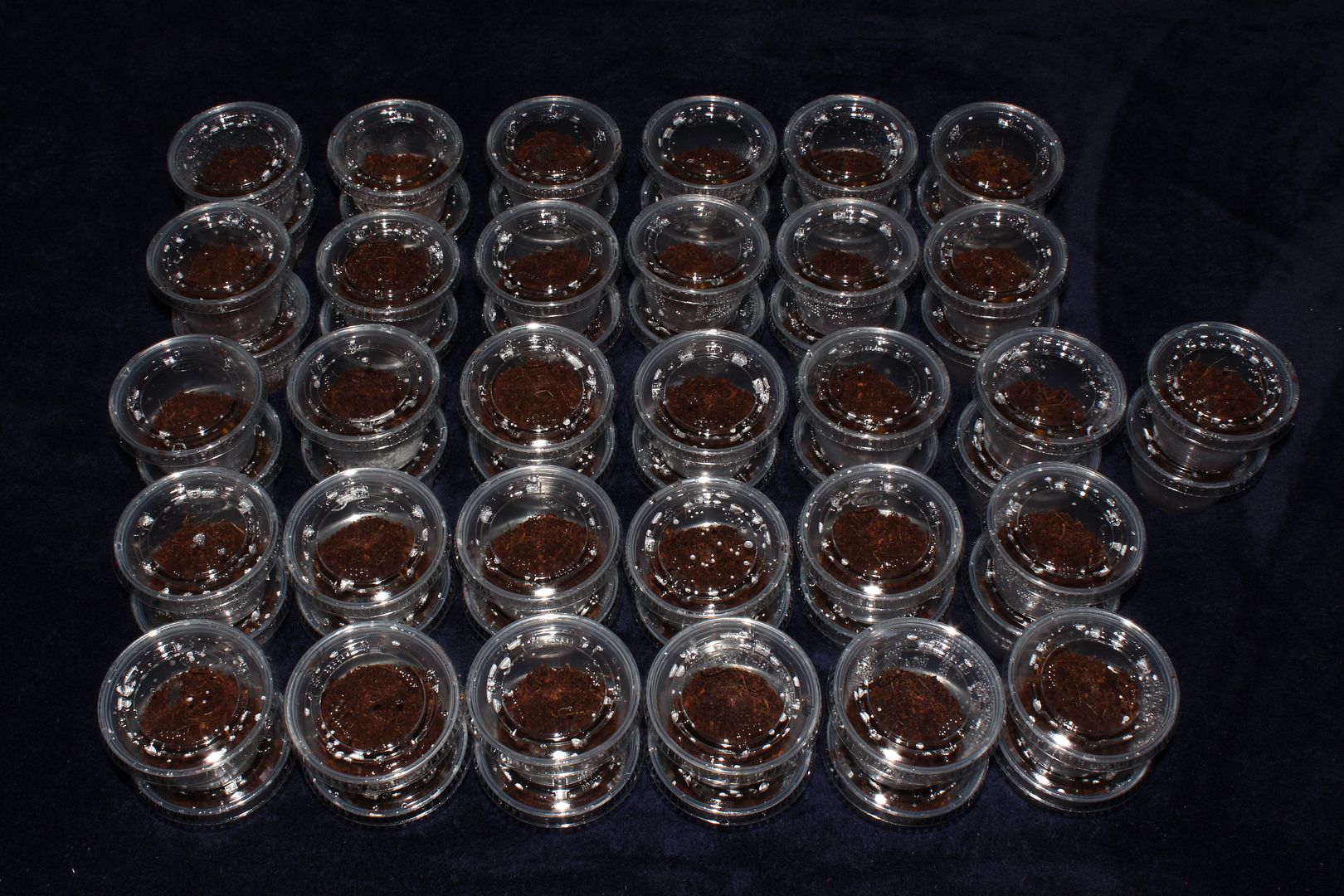- Joined
- Jul 27, 2009
- Messages
- 2,208
Breeding attempt successful.
Preparation
The female and male were purchased as adults in August, with the male being ~a month and a half mature, and the female having molted ~two months prior.
Both were kept in clear storage containers measuring 7"x6"x3.5" with a few ventilation holes on the cover.
They were kept relatively humid, and were allowed to acclimate to their enclosures. This took about two weeks. There was no additional heating or cooling during this (or any other) period, with temperatures inside ranging from the low to mid 70s. The female was observed to have webbed up a corner, and the male had spun at least one observable sperm web. Both were fed before the pairing.
Pairing
With the male being extremely high strung and flighty, it was decided to simply open both enclosures next to each other and let the male find his own way.
To do this, both enclosures were opened and placed next to each other in a larger bin.
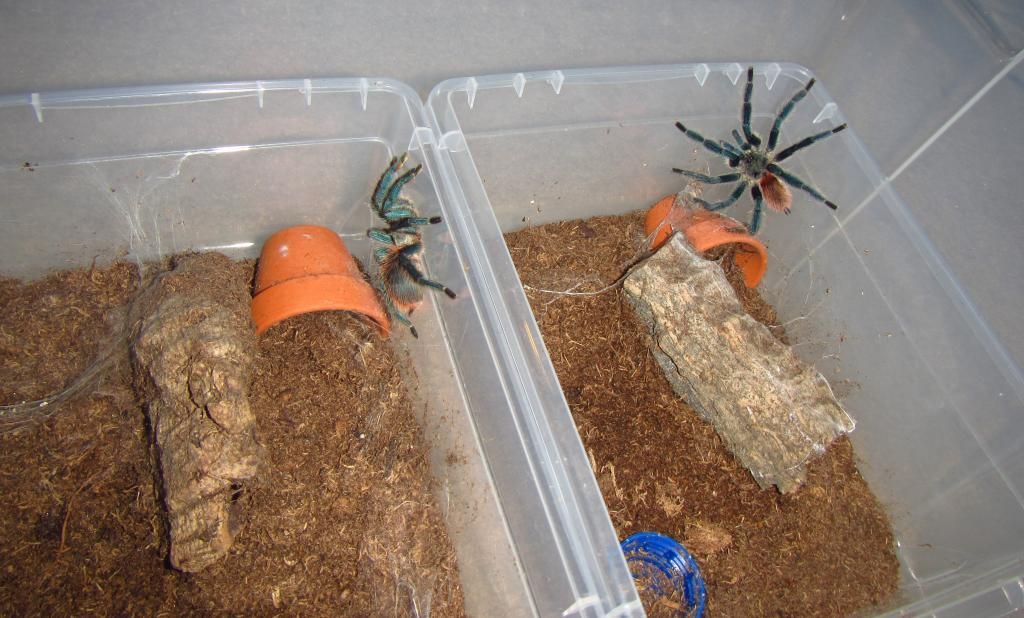
[SUP]The male and female enclosures.[/SUP]
Almost immediately, the male left his enclosure and began wandering around. It did not seem he detected the female as he was walking aimlessly around the bin. He did manage to touch the female's enclosure twice, but only turned around and began wandering again. The female remained motionless throughout his wandering, only moving to turn around.
The females enclosure was moved into the corner for a better chance of him finding it.
When he touched it a third time, he froze and began to vibrate and slowly walk with a quivering gait as he entered her enclosure. he was observed drumming his palps and vibrating whenever he stopped moving.

[SUP]Themale discovers the females enclosure.[/SUP]
The female then began to slowly walk towards his general direction, but did not tap, or respond to his vibrations as you would typically see. As if sensing the female's movements, the male slowly made his way away from her towards the opposite side, turned around, and resumed his vibrations. The female moved more quickly towards the male (who at this point was simply vibrating his legs and drumming his palps), and eventually made physical contact.

[SUP]Initial contact is made.[/SUP]
Upon contact, the male backed up quickly, climbing backwards up the side of her enclosure, and began to more intensely vibrate his body. Both Leg Is were held up above him and were twitched in synchronization with his vibrations, and leg IIs were now tapping right by the female. The female, though still not tapping, was reared back with fangs extended in what looked more like an invitation for insertions than a threat. The male continued his display while slowly backing up, with the female eventually retracting her fangs and slowly following him up, her front pairs of legs still slightly held up. In this manner, the male seemingly "led" the female backwards, up out of her enclosure and high up on the side of the bin. During this time he would have his leg IIs right under the females legs, and seemed to use his movements to encourage her to follow. If she was unresponsive for a while, he would respond with a more violent gyration of his body. The female would follow, and sometimes extend her fangs in seeming anticipation for insertions. Shortly after reaching the rim of the bin, he finally decided to go in for insertions. She was very receptive, rearing up, and baring her fangs for him to hook on to. Multiple insertions were observed from each palp before they broke apart, the female charging at him.
The male, in response, began to tap her with all his front legs, while the female still seeming to be in insertion more (or perhaps an actual threat pose this time) had her fangs extended and was still following the male.
Eventually they came to rest holding up each other's front legs.
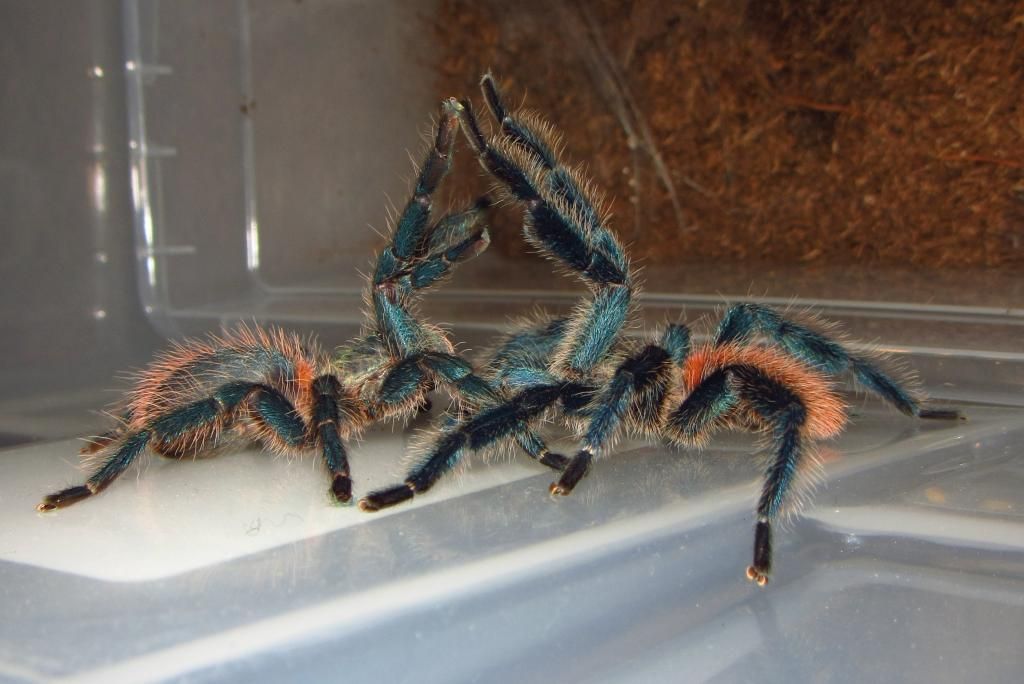
[SUP]Insertions complete, the pair take a rest.[/SUP]
At this point, to avoid any potential hostility between the two, they were separated and placed back into their respective enclosures.
This was the only pairing to take place in this breeding project.
Below is a video of most of the courtship and insertions.
[YOUTUBE]u5x4fmBsQgI[/YOUTUBE]
Eggsac preparation and brooding
After the pairing, the female was continually kept in the manner as she was kept before. She was not fed any more than usual. She continued to web up her enclosure, but became partial to an area directly above a small flower pot. She had created a small bowl type of structure there, but did no more than that for at least two weeks.
A little less than three weeks later from the pairing (though it could have been anytime a week prior, as I was away from home) an eggsac was observed. It was laid directly above her favored spot above the flower pot, and was a suspended "hammock" style sac. She sat directly above it, with the whole thing encased in layers of silk.
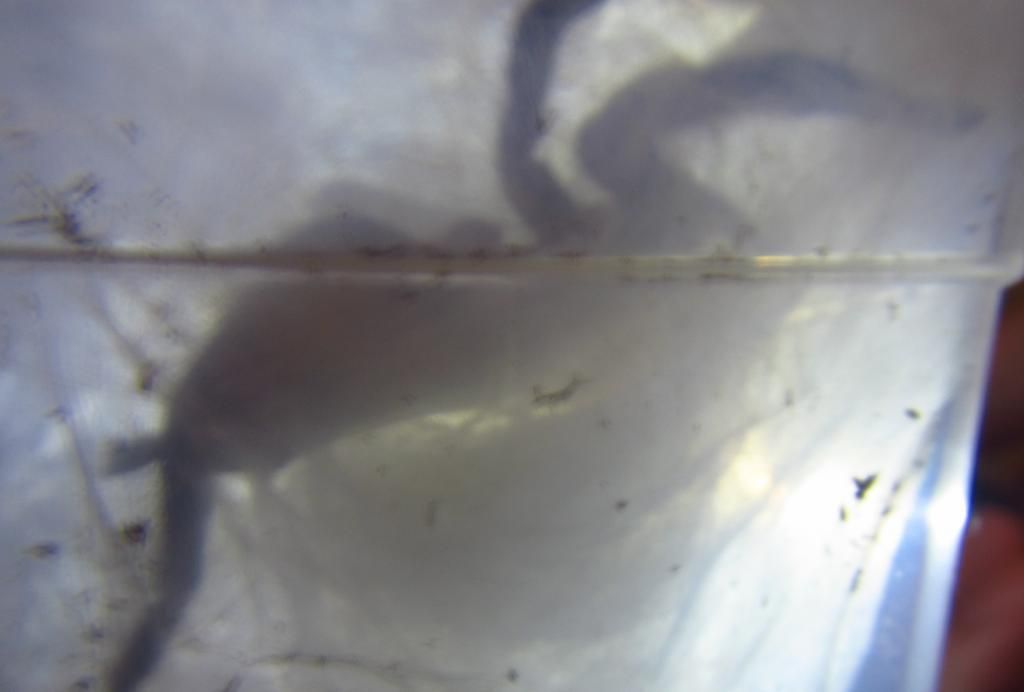
[SUP]The female and her eggsac.[/SUP]
To aid humidity, water was dripped trough ventilation holes on the opposite side of the sac, until half the sub was moistened with water.
With her abdomen almost alarmingly thin, and the fact she emerged from the web pocket several times to drink, she was fed two prey items as well, which she readily ate.
Pulling the eggsac
The sac was pulled at about three weeks after discovery, mainly so development could be observed.
The emptied sac was returned to the female. She webbed it back down above the flowerpot and moved it around for a couple of days before discarding it permanently in the water dish.
The eggsac contained 93 first instars, and one post embryo. No bad eggs or evidence of cannibalism were observed.

[SUP]"Hammock" style eggsac[/SUP]
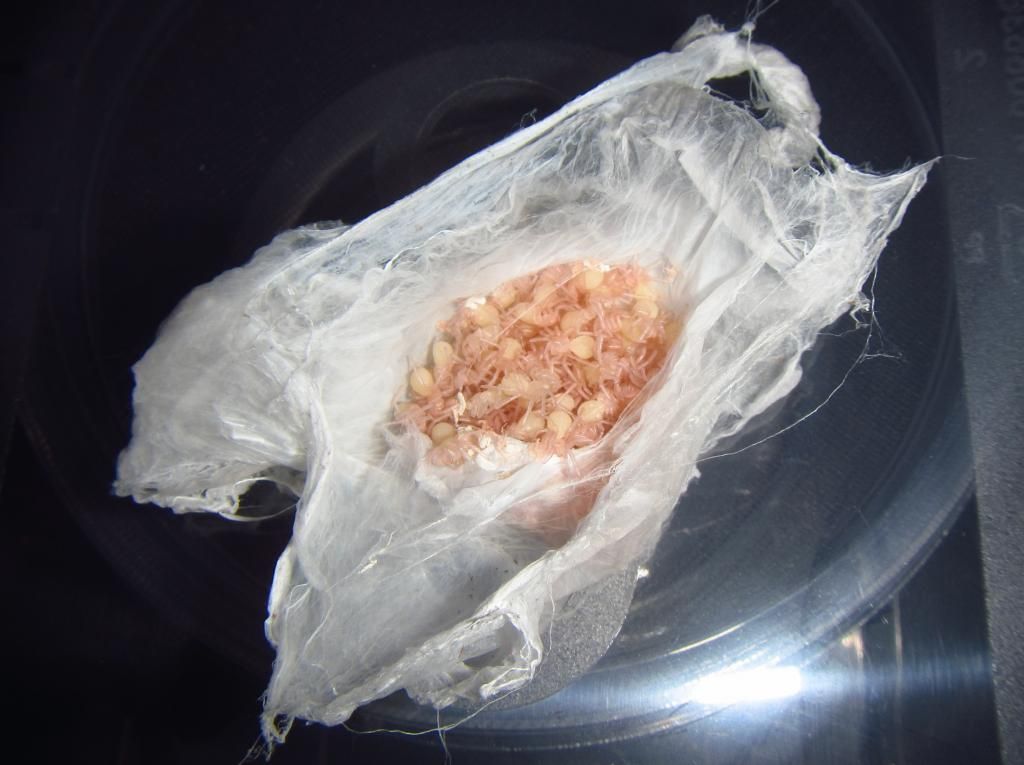
[SUP]Opened eggsac, containing first instars.[/SUP]
Incubating and caring for first instars
The first instars were incubated suspended on pantyhose over water using a delicup with the top cut off and pantyhose wrapped around the bottom. This was placed in a larger plastic container lined with wet paper towel. Four very tiny ventilation holes were added to the lid to keep humidity up, and to help keep pests (phorid flies, etc.) out.

[SUP]Incubator, cover off.[/SUP]
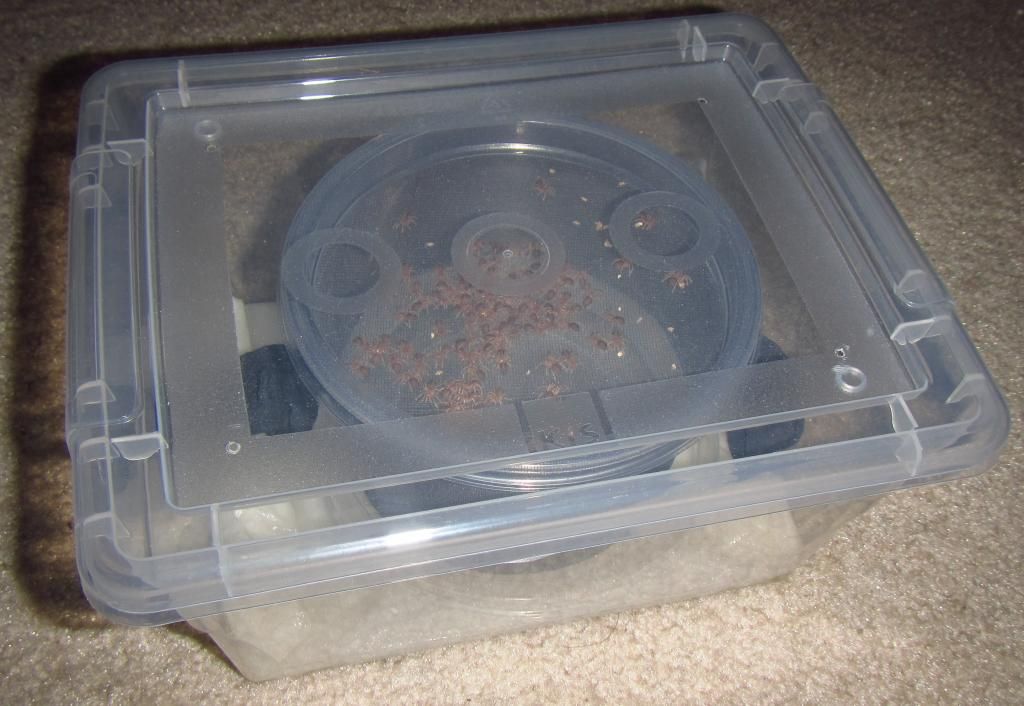
[SUP]Incubator, cover on. Note the four small holes in each corner.[/SUP]
As with the rest of the project, no exact temperatures or humidity numbers were recorded, but ambient temps inside the spider room are in the low to mid 70s. The incubator was opened at least once a day during observation.
post embryos to first instars
The one lone post embryo had molted into first instar by the next day, so it's suspected that these first instars had molted relatively recently.
First instars to second instars
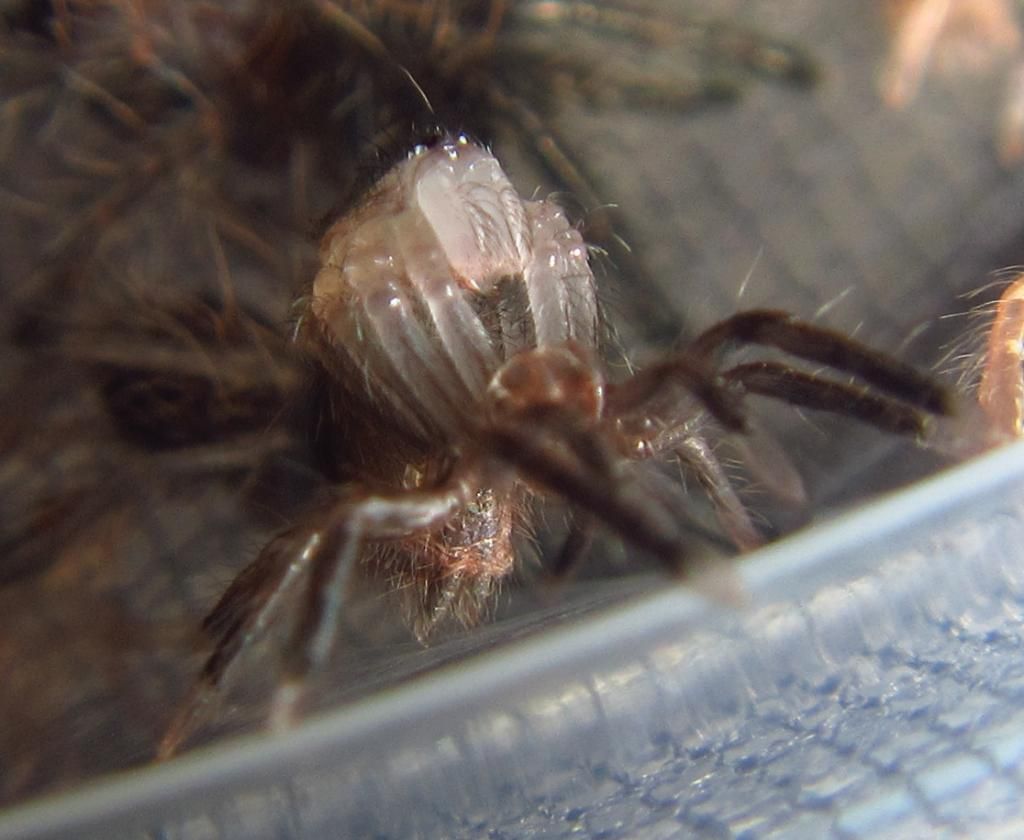
[SUP]First instar, molting into second instar.[/SUP]
First instars took about one month to reach second instar.
When they were freshly removed from the sac, they were creamy white, and could barely convey themselves. Towards the end of their month of incubation, they began to move like actual spiders, and even began to lay down webbing.
Some water droplets were added towards the end of their development, more for photo ops than for necessity. Most of them were able to make it without touching a drop of water.
The slings took three days to all molt into second instar. Before molting, it was observed that they often adopt a "pokie stance" prior to molting.
No cannibalism was observed, and all first instars successfully molted into second instars. They were separated shortly after.
[YOUTUBE]NOOYbEEjfvI[/YOUTUBE]
Timeline
August 13 2013 - First and only pairing
September 1 2013 - Sac discovered
September 25 2013 - Sac pulled
September 26 2013 - remaining post embryo molted into first instar
October 16 2013 - First instars start molting into second instars
October 19 2013 - Last of the first instars molt into second instar, 94 viable slings

[SUP]second instars.[/SUP]
Preparation
The female and male were purchased as adults in August, with the male being ~a month and a half mature, and the female having molted ~two months prior.
Both were kept in clear storage containers measuring 7"x6"x3.5" with a few ventilation holes on the cover.
They were kept relatively humid, and were allowed to acclimate to their enclosures. This took about two weeks. There was no additional heating or cooling during this (or any other) period, with temperatures inside ranging from the low to mid 70s. The female was observed to have webbed up a corner, and the male had spun at least one observable sperm web. Both were fed before the pairing.
Pairing
With the male being extremely high strung and flighty, it was decided to simply open both enclosures next to each other and let the male find his own way.
To do this, both enclosures were opened and placed next to each other in a larger bin.

[SUP]The male and female enclosures.[/SUP]
Almost immediately, the male left his enclosure and began wandering around. It did not seem he detected the female as he was walking aimlessly around the bin. He did manage to touch the female's enclosure twice, but only turned around and began wandering again. The female remained motionless throughout his wandering, only moving to turn around.
The females enclosure was moved into the corner for a better chance of him finding it.
When he touched it a third time, he froze and began to vibrate and slowly walk with a quivering gait as he entered her enclosure. he was observed drumming his palps and vibrating whenever he stopped moving.

[SUP]Themale discovers the females enclosure.[/SUP]
The female then began to slowly walk towards his general direction, but did not tap, or respond to his vibrations as you would typically see. As if sensing the female's movements, the male slowly made his way away from her towards the opposite side, turned around, and resumed his vibrations. The female moved more quickly towards the male (who at this point was simply vibrating his legs and drumming his palps), and eventually made physical contact.

[SUP]Initial contact is made.[/SUP]
Upon contact, the male backed up quickly, climbing backwards up the side of her enclosure, and began to more intensely vibrate his body. Both Leg Is were held up above him and were twitched in synchronization with his vibrations, and leg IIs were now tapping right by the female. The female, though still not tapping, was reared back with fangs extended in what looked more like an invitation for insertions than a threat. The male continued his display while slowly backing up, with the female eventually retracting her fangs and slowly following him up, her front pairs of legs still slightly held up. In this manner, the male seemingly "led" the female backwards, up out of her enclosure and high up on the side of the bin. During this time he would have his leg IIs right under the females legs, and seemed to use his movements to encourage her to follow. If she was unresponsive for a while, he would respond with a more violent gyration of his body. The female would follow, and sometimes extend her fangs in seeming anticipation for insertions. Shortly after reaching the rim of the bin, he finally decided to go in for insertions. She was very receptive, rearing up, and baring her fangs for him to hook on to. Multiple insertions were observed from each palp before they broke apart, the female charging at him.
The male, in response, began to tap her with all his front legs, while the female still seeming to be in insertion more (or perhaps an actual threat pose this time) had her fangs extended and was still following the male.
Eventually they came to rest holding up each other's front legs.

[SUP]Insertions complete, the pair take a rest.[/SUP]
At this point, to avoid any potential hostility between the two, they were separated and placed back into their respective enclosures.
This was the only pairing to take place in this breeding project.
Below is a video of most of the courtship and insertions.
[YOUTUBE]u5x4fmBsQgI[/YOUTUBE]
Eggsac preparation and brooding
After the pairing, the female was continually kept in the manner as she was kept before. She was not fed any more than usual. She continued to web up her enclosure, but became partial to an area directly above a small flower pot. She had created a small bowl type of structure there, but did no more than that for at least two weeks.
A little less than three weeks later from the pairing (though it could have been anytime a week prior, as I was away from home) an eggsac was observed. It was laid directly above her favored spot above the flower pot, and was a suspended "hammock" style sac. She sat directly above it, with the whole thing encased in layers of silk.

[SUP]The female and her eggsac.[/SUP]
To aid humidity, water was dripped trough ventilation holes on the opposite side of the sac, until half the sub was moistened with water.
With her abdomen almost alarmingly thin, and the fact she emerged from the web pocket several times to drink, she was fed two prey items as well, which she readily ate.
Pulling the eggsac
The sac was pulled at about three weeks after discovery, mainly so development could be observed.
The emptied sac was returned to the female. She webbed it back down above the flowerpot and moved it around for a couple of days before discarding it permanently in the water dish.
The eggsac contained 93 first instars, and one post embryo. No bad eggs or evidence of cannibalism were observed.

[SUP]"Hammock" style eggsac[/SUP]

[SUP]Opened eggsac, containing first instars.[/SUP]
Incubating and caring for first instars
The first instars were incubated suspended on pantyhose over water using a delicup with the top cut off and pantyhose wrapped around the bottom. This was placed in a larger plastic container lined with wet paper towel. Four very tiny ventilation holes were added to the lid to keep humidity up, and to help keep pests (phorid flies, etc.) out.

[SUP]Incubator, cover off.[/SUP]

[SUP]Incubator, cover on. Note the four small holes in each corner.[/SUP]
As with the rest of the project, no exact temperatures or humidity numbers were recorded, but ambient temps inside the spider room are in the low to mid 70s. The incubator was opened at least once a day during observation.
post embryos to first instars
The one lone post embryo had molted into first instar by the next day, so it's suspected that these first instars had molted relatively recently.
First instars to second instars

[SUP]First instar, molting into second instar.[/SUP]
First instars took about one month to reach second instar.
When they were freshly removed from the sac, they were creamy white, and could barely convey themselves. Towards the end of their month of incubation, they began to move like actual spiders, and even began to lay down webbing.
Some water droplets were added towards the end of their development, more for photo ops than for necessity. Most of them were able to make it without touching a drop of water.
The slings took three days to all molt into second instar. Before molting, it was observed that they often adopt a "pokie stance" prior to molting.
No cannibalism was observed, and all first instars successfully molted into second instars. They were separated shortly after.
[YOUTUBE]NOOYbEEjfvI[/YOUTUBE]
Timeline
August 13 2013 - First and only pairing
September 1 2013 - Sac discovered
September 25 2013 - Sac pulled
September 26 2013 - remaining post embryo molted into first instar
October 16 2013 - First instars start molting into second instars
October 19 2013 - Last of the first instars molt into second instar, 94 viable slings

[SUP]second instars.[/SUP]

